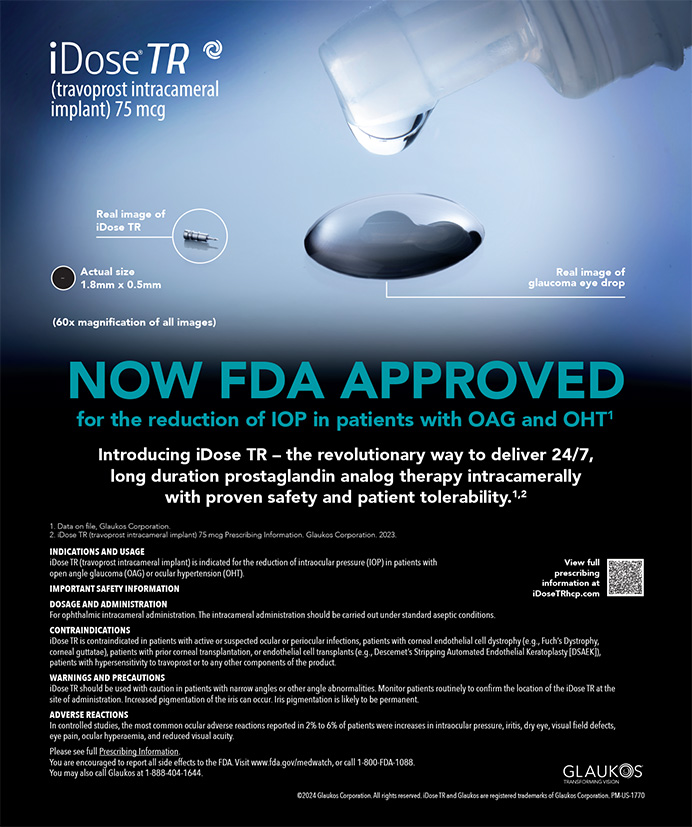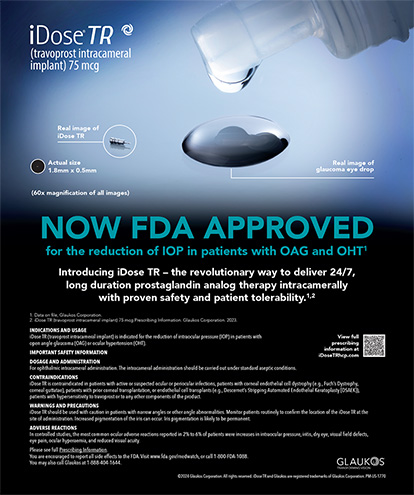As patients' expectations and technological progress continue to advance the quest for “precision vision,” rate-limiting factors that can hinder the objective and subjective results of cataract and refractive surgery become ever more subtle. Because the tear-cornea interface is the most powerful refractive component of the eye, it follows that the multiple manifestations of ocular surface disease (OSD) have major visual—as well as symptomatic—implications.
This article focuses on the diagnostic aspects of the ocular surface's Big Four, specifically, tears, lids, blinks, and sensation.
TEARS
More than 20 million Americans suffer from dry eye disease (DED) and its variations. Although the condition occurs predominantly in women more than 50 years of age, it is also prevalent in patients with rheumatoid arthritis and many other connective tissue and autoimmune diseases.1 The assessment of aqueous tear production remains paramount. Despite the variability of even the basic Schirmer test (with topical anesthesia), this time-honored method remains my gold standard. In particular, I regard test values of less than 5 mm per 5 minutes as significantly diminished. Such eyes likely require tear supplementation (ie, lubricants), stimulation (ie, cyclosporine), or retention (ie, punctal occlusion) prior to surgical intervention. Normal test values of basic secretions (ie, > 5 mm/5 min) serve to discourage the all-too-frequent use of artificial tears and lubricants, especially if they contain preservatives. The potential for ocular surface toxicity and/or allergy so often renders the treatment worse than the disease.
The assessment of tear function is critical prior to laser vision correction (LVC), and it is also of concern in some patients undergoing cataract surgerty, especially if they have concomitant OSD (as discussed later). With every prospective LVC patient, I personally assess the stability of the fluorescein-stained tear film, the adequacy of the inferior marginal tear strip, and the presence of superficial punctate keratitis. I note the values obtained in the pre-LVC evaluation record and thereby have documentation should postsurgical ocular surface conditions or complaints arise.
The meibomian gland-derived lipids and the mucin contributions of conjunctival goblet cells constitute the other two important tear components.2 Because both are critical to the stability of the tear film, their abnormalities decrease tear film breakup time and accelerate tear evaporation, the end result's being the so-called dry wet eye. Disorders of the meibomian glands are as ubiquitous as chronic blepharitis. In contrast, mucin deficiency usually results from disease-specific conjunctival cicatrizing conditions such as Stevens-Johnson syndrome, toxic epidermal necrolysis, ocular cicatricial pemphigoid, trachoma, atopy, chemical burn, graft-versus-host disease, or xerophthalmia.2 Clinicians' ability to quantitatively assess the tear lipid layer advanced remarkably with the FDA's recent approval of a tear lipid interferometer, the LipiView device (and its therapeutic companion, the LipiFlow Thermal Pulsation System; both from TearScience), that is not as yet widely in use. Additional instruments that measure tear osmolarity (TearLab Corporation) and lysozyme add objective metrics to assist in DED's diagnosis.
LIDS
To evaluate the eyelids, I first examine the skin of the patient's entire midface. Specifically, I look for subtle or perhaps even cosmetically concealed inflammatory and telangiectatic dermatitis and sebaceous gland hypertrophy characteristic of rosacea dermatitis. This condition is relevant for its strong association with meibomian gland dysfunction (MGD).3 Although most prevalent in white individuals, rosacea also occurs among blacks and Asians in whom the findings may not be obvious. I also assess the eyelid skin itself for erythema, roughness, fissuring, and scaling. The last is indicative of seborrhea or of a neurodermatitis, especially atopy with a predisposition to allergic as well as infectious keratoconjunctivitis (Figure 1).
Clinicians' increased appreciation of the importance of tear lipid components has heightened their awareness of posterior eyelid margin disease and MGD responsible for chronic blepharitis.4 The signs and consequences of chronic blepharitis are myriad, comprising lid margin erythema and thickening, cilia misdirection and loss, conjunctival papillary and follicular reactions, plus hordeola and chalazia. Chronic meibomian gland infection (most commonly by Staphylococcus aureus, Staphylococcus epidermidis, or Propionibacterium acnes) and inspissation alter the consistency of the sebaceous secretions. Hence, the most valuable diagnostic maneuver is performed at the slit lamp, when meibomian secretion is expressed by applying pressure with the examiner's index fingernail at the base of the lash line. What I have termed the toothpaste sign is almost invariably diagnostic of MGD, as the normally easily expressed and clear oily meibum is instead reluctantly disgorged as an opaque dentifrice (Figure 2).
As essential as MGD management is to the optimization of cataract and refractive surgical outcomes, the consequences of chronic MGD are critical to the health of the entire ocular surface. Chronic MGD can progress inexorably to involve corneal phlyctenules, marginal infiltrates, ulceration and thinning, neovascularization, pseudopterygia, episcleritis, and scleritis. Hence, the worth of an ounce of prevention is altogether self-evident.
Advances in contact lenses' design, materials, and care systems have greatly reduced the prevalence of giant papillary conjunctivitis of the superior tarsal conjunctiva. However, as many an LVC seeker is motivated by contact lens intolerance, the clinician must remain vigilant for giant papillary conjunctivitis, readily evident on eversion of the upper lid. Other contact lens-related adverse effects on the ocular surface like chronic diffuse superficial keratitis or even conjunctivalization are most likely caused by chemical reactions to lens care solutions. These are slow to resolve even months after complete cessation of contact lens wear as well as the use of topical medication and a lubricant.
Finally, the position of the lids and adnexae is important. Issues include the “innies and outies” of entropion and ectropion as well as age-related laxity of the lower lid with hammock-like contour distortion, leading to pooling tears and epiphora. Upper lid hyperelasticity or floppy eyelid syndrome is relevant as it relates not only to chronic papillary conjunctivitis but also to the specific propensity of the unstable eyelid to displace LASIK flaps. The miscellany of punctal malposition or occlusion, nasolacrimal duct obstruction (readily assessed by fluorescein retention testing in preference to probing and irrigation), trichiasis, and lid margin keratinization all deserve assessment, given their impact on the ocular surface.
BLINKS
Both the blink rate and how completely the eyelids close are relevant to the health of the ocular surface. The “computer stare” greatly reduces blink frequency. The resultant drying of the ocular surface's exposure zone can precipitate dry eye symptoms even among young LVC patients. Reduced blink frequency is also common among contact lens wearers and is especially severe in patients with Parkinson and thyroid eye disease. It is best to assess blink frequency by discreet observation while engaging the patient in unrelated discussion in order to avoid the artifact of the patient's awareness.
Among LVC candidates are many youth-seeking baby boomers who have also undergone cosmetic blepharoplasty, which has tightened their eyelids to the point of causing an incomplete blink and consequent corneal exposure. Similar mechanical lagophthalmos and corneal exposure are prevalent in individuals with thyroid ophthalmopathy. Nocturnal lagophthalmos, especially common among Asian individuals, can be reasonably discerned by requesting gentle, relaxed lid closure, as in “pretend you are sleeping.”
SENSATION
Corneal sensation is essential for the maintenance of the corneal epithelium's quality and the tear film's stability, for blink generation, for afferent stimulation of aqueous tear secretion, for awareness of foreign bodies on and abrasions of the ocular surface, and for corneal epithelial wound healing. Decreased or even absent corneal sensation is surprisingly common among patients with diabetes and should be evaluated prior to LVC procedures. Moreover, as the diabetic patient's corneal epithelium also has an intrinsic defect of the basement membrane adhesion complex, extensive epithelial defects can result during the creation of the LASIK flap and its manipulation—even when the surgeon uses a femtosecond laser with minimal epithelial surface shearing.
Other etiologies of the neurotrophic cornea include herpes simplex or zoster and less commonly involve trigeminal nerve resection, acoustic neuroma removal, and familial dysautonomia.
Corneal sensation testing is most simply and instantaneously performed at the slit lamp. I lightly touch the drawn out end of a cotton-tipped applicator to the corneal surface (prior to the application of topical anesthetics) while observing and requesting the patient's response.
Common Corneal Comorbidities
These discrete components of OSD seldom occur in isolation. Rather, they overlap like a Venn diagram, thereby adding to the complexity of the diagnosis and challenges of management. For older patients in particular, the concomitant problems of blepharitis, DED, possible lid malpositions, and toxicity from multiple topical medications serve to synergistically confound the cycle of chronic OSD.
A few additional factors deserve attention. Given the current polypharmacy tendencies of patients in terms of medical and nutritional therapy, it is important to be aware of the sometimes profound ocular drying effects of the “anti” medications such as antidepressants, anticholinergics, antihistamines, and anticonception agents (birth control pills) as well as diuretics. Diets high in omega-6 and low in omega-3 fatty acids are implicated in DED, as are some hormone replacement therapies and other various nutritional supplements.5
Although most prevalent in older individuals, epithelial basement membrane (map-dot-fingerprint) dystrophy and Salzmann degeneration are often subtly evident in younger adults. Not only do these superficial corneal disorders destabilize the tear film, distort vision with ghost image diplopia, and precipitate recurrent epithelial erosions, but they can also induce unpredictable refractive shifts and irregular astigmatism as well as cause difficulty with the LASIK flap's creation.
CONCLUSION
Despite the ever-increasing tempo of the demands of clinical practice, there is simply no substitute for careful history taking and physical examination, especially when dealing with patients' heightened expectations for cataract and refractive surgery. In dealing with OSDs that are frequently multifactorial and chronic, patience remains a virtue for both patients and practitioners. It takes time to devise and follow a structured strategy for managing OSD and improving the ocular surface. Only then is it appropriate to reassess a patient's overall candidacy for cataract or refractive surgery. At that time, I recommend repeating all refractive, wavefront, and topographic studies, the results of which may have changed significantly in the process, and reconsidering the optimal surgical plan. When it comes to the ocular surface, the words of Kitty Kallen (although first sung in 1954) still remain especially poignant as “Little Things Mean a Lot.”
Kenneth R. Kenyon, MD, is with Cornea Consultants International, Tufts University School of Medicine, Harvard Medical School, and the Schepens Eye Reserch Institute, Boston. He acknowledged no financial interest in the products or companies mentioned herein. Dr. Kenyon may be reached at (508) 994-1400; kenrkenyon@cs.com.


